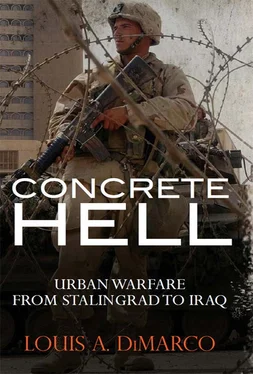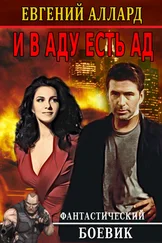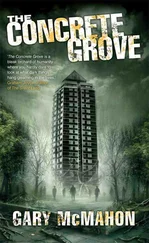A key to successful urban combat is anticipating the urban battle and preparing for it. The German commanders understood this. However, the operation to capture Stalingrad was not initially subject to close scrutiny because it was only a secondary objective of the campaign, and not decisive to obtaining the German army’s objective for the summer campaign, the Caucasus oil fields. In fact, the original plan had no requirement to capture Stalingrad, but rather merely required the German forces to contain Soviet forces and halt the production in the factories located there.
The German army had had experience of urban warfare during the Barbarossa campaign and earlier in the summer of 1942. They had captured numerous Russian cities including Minsk in the Ukraine, and Sevastopol in the Crimea, and as they approached Stalingrad, the northern army group was laying siege to the former Russian capital, Leningrad. Dozens of other medium-size Russian cities had been isolated by the German panzers and then captured when the German infantry caught up with the panzer columns. Early in Operation Blue, the Fourth Panzer Army became involved in a tough urban battle in and around the important transportation hub city at Voronezh. Because of that experience the German army had adequate knowledge of the intricacies and challenges of tactical urban warfare. Fighting the urban battle tactically was not a concern of the German military commanders as they approached Stalingrad. However, Hitler’s role in operations was a concern. Hitler, as the Nazi dictator of Germany, was the key to the German military failure at Stalingrad.
Operation Blue began in June 1942 and by mid-July had made important progress. The Germans, inhibited by a shortage of tanks, and fuel for the tanks they did have, found it difficult to complete the large encirclement operations that had characterized Barbarossa the previous year. Inadequate strength in troops, equipment, and fuel caused short delays throughout the approach to Stalingrad, which proved crucial. Still, there was significant operational success and the German Sixth Army had captured tens of thousands of Soviet troops and destroyed dozens of divisions by mid-summer. Even so, Soviet commanders managed to keep many of their major formations from being trapped and, though they lost most of their armored forces in the great retreat through southern Russia, they retained the core combat power of their divisions and avoided decisive defeat.
In the middle of July Hitler intervened in the summer campaign. He was unhappy with the rate of advance and ordered the launching of the offensive into the Caucasus as the advance to the Volga was ongoing. Thus, contrary to the original Operation Blue plan, which called for a sequenced advance of first Army Group B and then Army Group A attacking south into the Caucasus, Hitler Directive No. 45 ordered both army groups to attack simultaneously. This had several immediate effects. It strained the already overstrained logistics system. It also created two weaker efforts in the place of one strong attack. Finally, the two army groups’ objectives were on divergent axes, so the German formations moved further away from each other as the attacks progressed, to the point where they were not within supporting distance of each other.
As important as changing the sequencing of the offensive were Hitler’s changes to the orders regarding Stalingrad. Stalingrad was redesignated as a primary objective of the campaign. This change not only required the Sixth Army to capture the entire city, but required that resources which may have been used to reinforce the attack into the Caucuses were diverted to the Stalingrad battle.
The Germans began their final push to capture Stalingrad at the end of August 1942. By August 22, Sixth Army’s XIV Panzer Corps had entered the northern suburbs of the city and the following day the panzers reached the Volga north of the city. The rest of the Sixth Army, and XXVIII Panzer Corps under control of Sixth Army, pushed to the outskirts of the city. The XXVIII Panzer Corps managed to break through the Soviet Sixty-Fourth Army defending the southern portion of the city and race almost to the Volga threatening to trap part of the Sixty-Fourth Army and all of the Soviet Sixty-Second Army in the city’s outskirts. This success caused the two Soviet armies, the Sixty-Second and Sixty-Fourth, to give up the outer ring of the city’s defenses and withdraw into the city to avoid the trap. Thus, by the end of August the Germans were firmly in possession of the outskirts of the city and threatened it from three directions: north, west, and south. It appeared the fall of the entire city would happen in a matter of weeks.
The fighting for Stalingrad proper began on September 14, as German forces attempted to force their way into the city center. The battle for the city directly involved three German army corps: the XIV Panzer and LI Corps of the Sixth Army, and the XXVIII Panzer Corps of Fourth Panzer Army. The three German corps were opposed directly by two Soviet armies: the Sixty-Fourth and Sixty-Second Armies of the Stalingrad Front. The initial attacks were costly but successful. After about ten days of very intense fighting the two panzer and two infantry divisions of XXVIII Corps managed to destroy most of the Sixty-Fourth Army in the southern part of the city and seize about five miles of the Volga riverbank. In the center of the city, the combined forces of the LI and XIV Panzer Corps pushed the divisions of the Soviet General Vasily Chuikov’s Sixty-Second Army back toward theVolga and reduced the Soviets’ defensive parameter by half.
Despite the successes, the attacks of mid-September did not accomplish the Sixth Army’s mission. The task of the army was the capture of the city, not just, as it had initially been, to control the city. Thus on September 27, Sixth Army renewed the attacks to eliminate the presence of the Soviet Sixty-Second Army on the west bank of the Volga. The initial attacks had severely depleted many of the veteran units of the Sixth Army, particularly in the center of the line where the most significant attacks occurred. To compensate, most of XXVIII Panzer Corps was moved from the south into the central part of the sector. This gave the Germans two strong panzer divisions (the 24th and the 14th) and two motorized infantry divisions in the center.
The Soviets anticipated the German offensive and took steps to meet it. Their excellent intelligence network inside the city informed them that the focus of the attack would be in the center and north, aimed at the major Soviet defenses based at three large factory complexes in northern Stalingrad. From north to south these were the tractor factory complex, the Barrikady weapons factory complex, and the Red October factory facilities. These complexes were huge self-contained communities which included the factories themselves and the workers’ housing buildings. The buildings were massive structures constructed of steel girders and reinforced concrete. Many of the factory buildings included massive internal workshops large enough to house the emplacement of tanks and large-caliber guns to participate in the fight inside the building. After repeated air and artillery attacks, the complex and formidable defensive qualities of the buildings were actually enhanced due to extensive damage and accumulated rubble. To this the Soviet infantry added barbed wire, extensive minefields, deep protected trenches, and bunkers. By the end of September, the Soviet defensive positions in Stalingrad were every bit as formidable as the most notorious defenses of World War I.
The second major German attack into the city lasted ten days, from September 27 to October 7, and involved 11 full German divisions including all three panzer divisions. Like the first attack, it was successful and the Germans managed to capture two of the three major factory complexes: the tractor factory and the Barrikady factory. They also eliminated the Orlovka salient which was a deep Soviet defensive salient that had remained in the northern part of the city. Despite steady Red Army reinforcement which consistently frustrated a decisive German breakthrough, by the end of the attack the Sixty-Second Army was reduced to a tiny strip of the west bank of the Volga which at its widest was perhaps 2,200 yards (2,000 meters).
Читать дальше












